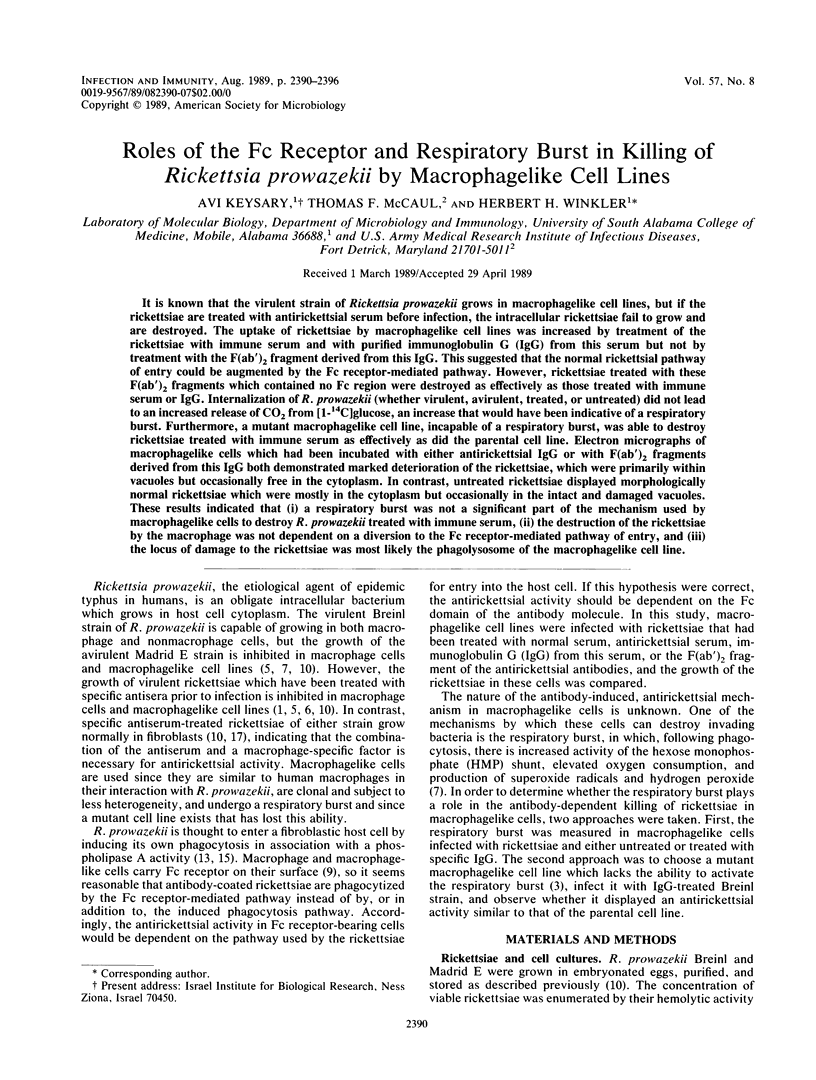Abstract
It is known that the virulent strain of Rickettsia prowazekii grows in macrophagelike cell lines, but if the rickettsiae are treated with antirickettsial serum before infection, the intracellular rickettsiae fail to grow and are destroyed. The uptake of rickettsiae by macrophagelike cell lines was increased by treatment of the rickettsiae with immune serum and with purified immunoglobulin G (IgG) from this serum but not by treatment with the F(ab')2 fragment derived from this IgG. This suggested that the normal rickettsial pathway of entry could be augmented by the Fc receptor-mediated pathway. However, rickettsiae treated with these F(ab')2 fragments which contained no Fc region were destroyed as effectively as those treated with immune serum or IgG. Internalization of R. prowazekii (whether virulent, avirulent, treated, or untreated) did not lead to an increased release of CO2 from [1-14C]glucose, an increase that would have been indicative of a respiratory burst. Furthermore, a mutant macrophagelike cell line, incapable of a respiratory burst, was able to destroy rickettsiae treated with immune serum as effectively as did the parental cell line. Electron micrographs of macrophagelike cells which had been incubated with either antirickettsial IgG or with F(ab')2 fragments derived from this IgG both demonstrated marked deterioration of the rickettsiae, which were primarily within vacuoles but occasionally free in the cytoplasm. In contrast, untreated rickettsiae displayed morphologically normal rickettsiae which were mostly in the cytoplasm but occasionally in the intact and damaged vacuoles. These results indicated that (i) a respiratory burst was not a significant part of the mechanism used by macrophagelike cells to destroy R. prowazekii treated with immune serum, (ii) the destruction of the rickettsiae by the macrophage was not dependent on a diversion to the Fc receptor-mediated pathway of entry, and (iii) the locus of damage to the rickettsiae was most likely the phagolysosome of the macrophagelike cell line.
Full text
PDF






Images in this article
Selected References
These references are in PubMed. This may not be the complete list of references from this article.
- Beaman L., Wisseman C. L., Jr Mechanisms of immunity in typhus infections. VI. Differential opsonizing and neutralizing action of human typhus rickettsia-specific cytophilic antibodies in cultures of human macrophages. Infect Immun. 1976 Oct;14(4):1071–1076. doi: 10.1128/iai.14.4.1071-1076.1976. [DOI] [PMC free article] [PubMed] [Google Scholar]
- Coulter A., Harris R. Simplified preparation of rabbit Fab fragments. J Immunol Methods. 1983 Apr 29;59(2):199–203. doi: 10.1016/0022-1759(83)90031-5. [DOI] [PubMed] [Google Scholar]
- Damiani G., Kiyotaki C., Soeller W., Sasada M., Peisach J., Bloom B. R. Macrophage variants in oxygen metabolism. J Exp Med. 1980 Oct 1;152(4):808–822. doi: 10.1084/jem.152.4.808. [DOI] [PMC free article] [PubMed] [Google Scholar]
- Gambrill M. R., Wisseman C. L., Jr Mechanisms of immunity in typhus infections. 3. Influence of human immune serum and complement on the fate of Rickettsia mooseri within the human macrophages. Infect Immun. 1973 Oct;8(4):631–640. doi: 10.1128/iai.8.4.631-640.1973. [DOI] [PMC free article] [PubMed] [Google Scholar]
- Gambrill M. R., Wisseman C. L., Jr Mechanisms of immunity in typhus infections. I. Multiplication of typhus rickettsiae in human macrophage cell cultures in the nonimmune system: influence of virulence of rickettsial strains and of chloramphenicol. Infect Immun. 1973 Oct;8(4):519–527. doi: 10.1128/iai.8.4.519-527.1973. [DOI] [PMC free article] [PubMed] [Google Scholar]
- Goren M. B. Phagocyte lysosomes: interactions with infectious agents, phagosomes, and experimental perturbations in function. Annu Rev Microbiol. 1977;31:507–533. doi: 10.1146/annurev.mi.31.100177.002451. [DOI] [PubMed] [Google Scholar]
- Kiyotaki C., Peisach J., Bloom B. R. Oxygen metabolism in cloned macrophage cell lines: glucose dependence of superoxide production, metabolic and spectral analysis. J Immunol. 1984 Feb;132(2):857–866. [PubMed] [Google Scholar]
- Ralph P., Nakoinz I., Broxmeyer H. E., Schrader S. Immunologic functions and in vitro activation of cultured macrophage tumor lines. Natl Cancer Inst Monogr. 1978 May;(48):303–310. [PubMed] [Google Scholar]
- Turco J., Winkler H. H. Differentiation between virulent and avirulent strains of Rickettsia prowazekii by macrophage-like cell lines. Infect Immun. 1982 Mar;35(3):783–791. doi: 10.1128/iai.35.3.783-791.1982. [DOI] [PMC free article] [PubMed] [Google Scholar]
- Walker T. S., Winkler H. H. Rickettsial hemolysis: rapid method for enumeration of metabolically active typhus rickettsiae. J Clin Microbiol. 1979 May;9(5):645–647. doi: 10.1128/jcm.9.5.645-647.1979. [DOI] [PMC free article] [PubMed] [Google Scholar]
- Winkler H. H., Daugherty R. M. Cytoplasmic distinction of avirulent and virulent Rickettsia prowazekii: fusion of infected fibroblasts with macrophage-like cells. Infect Immun. 1983 Jun;40(3):1245–1247. doi: 10.1128/iai.40.3.1245-1247.1983. [DOI] [PMC free article] [PubMed] [Google Scholar]
- Winkler H. H. Early events in the interaction of the obligate intracytoplasmic parasite, Rickettsia prowazekii, with eucaryotic cells: entry and lysis. Ann Inst Pasteur Microbiol. 1986 May-Jun;137A(3):333–336. doi: 10.1016/s0769-2609(86)80044-8. [DOI] [PubMed] [Google Scholar]
- Winkler H. H., Miller E. T. Phospholipase A and the interaction of Rickettsia prowazekii and mouse fibroblasts (L-929 cells). Infect Immun. 1982 Oct;38(1):109–113. doi: 10.1128/iai.38.1.109-113.1982. [DOI] [PMC free article] [PubMed] [Google Scholar]
- Winkler H. H. Rickettsial hemolysis: adsorption, desorption, readsorption, and hemagglutination. Infect Immun. 1977 Sep;17(3):607–612. doi: 10.1128/iai.17.3.607-612.1977. [DOI] [PMC free article] [PubMed] [Google Scholar]
- Wisseman C. L., Jr, Waddell A. D., Walsh W. T. In vitro studies of the action of antibiotics on Rickettsia prowazeki by two basic methods of cell culture. J Infect Dis. 1974 Dec;130(6):564–574. doi: 10.1093/infdis/130.6.564. [DOI] [PubMed] [Google Scholar]
- Wisseman C. L., Jr, Waddell A. D., Walsh W. T. Mechanisms of immunity in typhus infections. IV. Failure of chicken embryo cells in culture to restrict growth of antibody-sensitized Rickettsia prowazeki. Infect Immun. 1974 Mar;9(3):571–575. doi: 10.1128/iai.9.3.571-575.1974. [DOI] [PMC free article] [PubMed] [Google Scholar]




